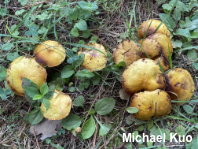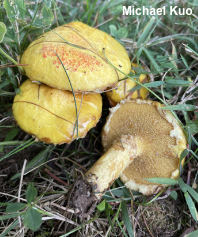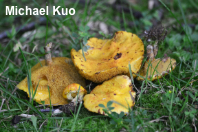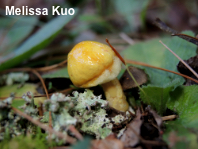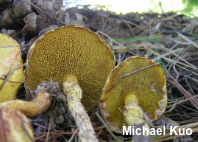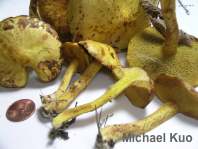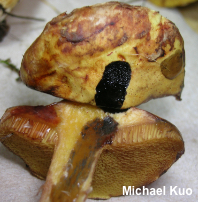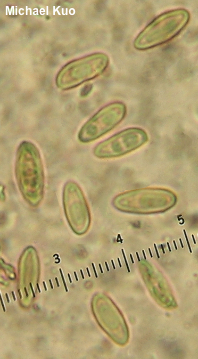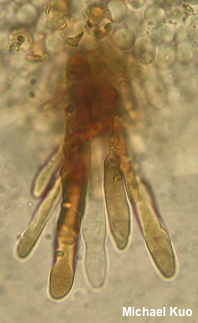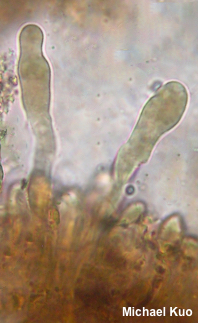| Major Groups > Boletes > Suillus > Suillus americanus |

|
Suillus americanus [ Basidiomycota > Boletales > Suillaceae > Suillus . . . ] by Michael Kuo "He lay flat on the brown, pine-needled floor of the forest, his chin folded on his arms, and high overhead the wind blew in the tops of the pine trees." It's a good thing that Robert Jordan, the main character in Hemingway's For Whom the Bell Tolls, was in Spain, where there are no native 5-needled pines, for this first sentence of the novel. Because, if he were under 5-needle pines in the Alps, Asia, or North America just after a late-summer rain, he might not have been able to see the bridge he was supposed to blow up, due to the hundreds of slimy yellow mushrooms growing among the pine trees. Suillus americanus can quickly turn a forest of 5-needled pine trees into a swamp of yellow slime. It can even turn your yard into a swamp of yellow slime, if there's a white pine tree planted within earshot. Distinguishing physical features for Suillus americanus include the sticky yellow cap with red to reddish brown fibers and scales, and partial veil tatters on the margin; the yellow pore surface with large, angular pores; and the tough, skinny stem, which bears glandular dots. Suillus sibiricus is a synonym; traditionally it was seen as a separate species from Eurasia and western North America, with a duller yellow, scalier cap, associated primarily with Siberian pine, Swiss pine, western white pine, and limber pine (all of which are 5-needled pines). However, Klofac (2013) synonymized Suillus sibiricus with Suillus americanus, and later research (Nguyen et al. 2016) supported the idea with DNA results from Asian, European, and North American collections. Varieties and forms of Suillus americanus have been described (var. americanus, var. reticulipes, f. americanus, f. helveticus, f. sibiricus, and f. pseudosibiricus); these "within-species morphological variants are expected for such a widespread distribution" (Nguyen et l. 2016). Suillus himalayensis is also a synonym. I suspect that Suillus flavoluteus, described in 1941 by Snell & Dick, is another synonym, based on the original description and comments, and on the comments of Smith & Thiers (1964), as well as the color illustration in Snell & Dick (1970). Thanks to Django Grootmyers for documenting, collecting, and preserving Suillus americanus for study; his collections are deposited in The Herbarium of Michael Kuo. Description: Ecology: Mycorrhizal with 5-needled pines—primarily eastern white pine, western white pine, limber pine, Siberian pine, and Swiss pine; typically growing gregariously (often densely so); late summer and fall; originally described from New York; widespread in North America wherever the host trees occur; also found in Europe and Asia where 5-needled pines occur. The illustrated and described collections are from Illinois, Indiana, Michigan, and Ohio. Cap: 3.5–8 cm across; convex with an inrolled margin when young, but soon broadly convex to flat; slimy to sticky when fresh; bright yellow to dull yellow, developing red to reddish brown stains; usually featuring scattered tiny red fibrils; often becoming sub-scaly in dry conditions or at high elevation; the margin with whitish to yellowish, reddish, or grayish veil remnants. Pore Surface: Yellow, becoming brownish yellow and eventually yellow-brown with age; sometimes (but not always) bruising slowly brown to reddish brown; pores angular and vaguely radially arranged (but not boletinoid), Stem: 3–8 cm long; up to about 1.5 cm thick; equal, but frequently crooked or bent; yellow above and brownish yellow to brownish (or sometimes reddish in old age) below; with brown to reddish brown glandular dots; occasionally with a ring or ring zone, but usually bare; frequently bruising slowly reddish brown; basal mycelium whitish to pink. Flesh: Yellow throughout, but darker yellow in the stem; unchanging, or staining slowly pinkish to purplish brown when sliced. Odor and Taste: Odor not distinctive; taste slightly acidic. Chemical Reactions: Ammonia red (soon fading to pink or negative) on cap surface; red fading top grayish pink on flesh. KOH black on cap; black on flesh. Iron salts negative to gray on cap; negative to grayish or slightly greenish on flesh. Spore Print: Brown to cinnamon brown. Microscopic Features: Spores 8–10.5 (–12) x 3–4 µm; boletoid-fusiform; smooth; hyaline to yellowish in KOH. Basidia 22–28 x 4–7 µm; subclavate; 4-sterigmate. Cystidia in bundles; sometimes poorly defined individually; 30–80 x 4–12 µm; varying from cylindric to subclavate, subfusiform, narrowly utriform or somewhat irregular; smooth; thin-walled; brown in KOH. Pileipellis an ixocutis; elements 2.5–8 µm wide, smooth, hyaline in KOH. REFERENCES: (C. H. Peck, 1887) W. H. Snell, 1959. (Coker & Beers, 1943; Smith & Thiers, 1964; Snell & Dick, 1970; Smith & Thiers, 1971; Grund & Harrison, 1976; Smith, Smith & Weber, 1981; States, 1990; Breitenbach & Kränzlin, 1991; Phillips, 1991/2005; Lincoff, 1992; Both, 1993; Barron, 1999; Bessette, Roody & Bessette, 2000; Nonis, 2001; Roody, 2003; McNeil, 2006; Miller & Miller, 2006; Kuo, 2007; Klofac, 2013; Kuo & Methven, 2014; Nguyen et al., 2016; Cripps, Evenson & Kuo, 2017; Baroni, 2017; Sturgeon, 2018; Klofac & Krisai-Greilhuber, 2020; McKnight et al., 2021.) Herb. Kuo 09259402, 09019517, 09100101, 10030401, 08191404, 10021401, 09231504, 10181601. Herb. EIU 015. This site contains no information about the edibility or toxicity of mushrooms. |
© MushroomExpert.Com |
|
Cite this page as: Kuo, M. (2022, August). Suillus americanus. Retrieved from the MushroomExpert.Com Web site: http://www.mushroomexpert.com/suillus_americanus.html |
